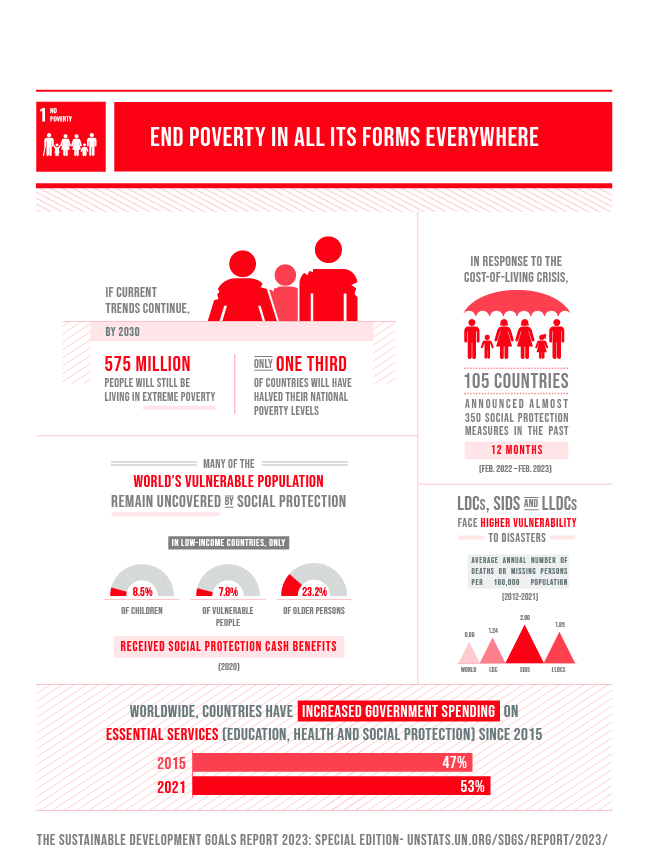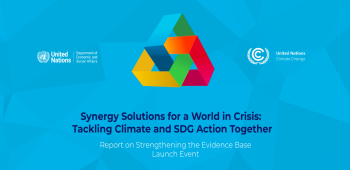
Poverty eradication
Overview
Targets and Indicators

1.1
By 2030, eradicate extreme poverty for all people everywhere, currently measured as people living on less than $1.25 a day
1.1.1
Proportion of the population living below the international poverty line by sex, age, employment status and geographical location (urban/rural)

1.2
By 2030, reduce at least by half the proportion of men, women and children of all ages living in poverty in all its dimensions according to national definitions
1.2.1
Proportion of population living below the national poverty line, by sex and age
1.2.2
Proportion of men, women and children of all ages living in poverty in all its dimensions according to national definitions

1.3
Implement nationally appropriate social protection systems and measures for all, including floors, and by 2030 achieve substantial coverage of the poor and the vulnerable
1.3.1
Proportion of population covered by social protection floors/systems, by sex, distinguishing children, unemployed persons, older persons, persons with disabilities, pregnant women, newborns, work-injury victims and the poor and the vulnerable

1.4
By 2030, ensure that all men and women, in particular the poor and the vulnerable, have equal rights to economic resources, as well as access to basic services, ownership and control over land and other forms of property, inheritance, natural resources, appropriate new technology and financial services, including microfinance
1.4.1
Proportion of population living in households with access to basic services
1.4.2
Proportion of total adult population with secure tenure rights to land, (a) with legally recognized documentation, and (b) who perceive their rights to land as secure, by sex and by type of tenure

1.5
By 2030, build the resilience of the poor and those in vulnerable situations and reduce their exposure and vulnerability to climate-related extreme events and other economic, social and environmental shocks and disasters
1.5.1
Number of deaths, missing persons and directly affected persons attributed to disasters per 100,000 population
1.5.2
Direct economic loss attributed to disasters in relation to global gross domestic product (GDP)
1.5.3
Number of countries that adopt and implement national disaster risk reduction strategies in line with the Sendai Framework for Disaster Risk Reduction 2015-2030
1.5.4
Proportion of local governments that adopt and implement local disaster risk reduction strategies in line with national disaster risk reduction strategies

1.a
Ensure significant mobilization of resources from a variety of sources, including through enhanced development cooperation, in order to provide adequate and predictable means for developing countries, in particular least developed countries, to implement programmes and policies to end poverty in all its dimensions
1.a.1
Total official development assistance grants from all donors that focus on poverty reduction as a share of the recipient country's gross national income
1.a.2
Proportion of total government spending on essential services (education, health and social protection)

1.b
Create sound policy frameworks at the national, regional and international levels, based on pro-poor and gender-sensitive development strategies, to support accelerated investment in poverty eradication actions
1.b.1
Pro-poor public social spending
Progress and Info
Global efforts to eradicate extreme poverty have faced significant setbacks by the COVID-19 pandemic and a series of major shocks during 2020-22. The pandemic caused extreme poverty to increase in 2020 for the first time in decades, reversing global progress by three years. Recovery has been uneven, with low-income countries lagging behind. With the ongoing poly-crisis, ending poverty by 2030 appears increasingly out of reach, particularly in regions that lack the fiscal capacity to cope with economic stresses.
Target 1.1: o Extreme poverty levels returned to pre-pandemic levels in most countries by 2022, except in low-income countries where recovery has been slower. In 2022, 9% of the world's population or 712 million people were living in extreme poverty, an increase of 23 million people compared to 2019. If current trends continue, 590 million people, or 6.9% of the world’s population will still live in extreme poverty by 2030.
o The share of the world’s working population living in poverty has steadily decreased, from 8.4% in 2015 to 6.9% in 2023. However, nearly 241 million workers globally were still living in extreme poverty in 2023 and little positive change is expected in 2024.
Target 1.2: Though data covering the period of COVID-19 are limited, the pandemic is likely to have slowed progress made in halving national poverty rates. Given historical trends, less than 30% of countries worldwide will have halved poverty by 2030.
Target 1.3: In 2023, only 28.2% of child globally received child cash benefits, compared to 22.1% in 2015, leaving 1.4 billion children aged 0-15 without coverage. To guarantee at least a basic level of social protection for all children, upper- and lower-middle-income countries would need to invest an additional US$98.1 billion and US$88.8 billion, respectively, while low-income countries would require an additional US$59.6 billion.
Target 1.5: Economic losses due to disasters remained stubbornly high in recent years and showed no sign of alleviation. Between 2015 and 2022 direct economic loss has been reported to exceed more than $115 billion per year worldwide, which amounted to 0.3% of the GDP of the reporting countries.
Target 1.a: Data from approximately 100 countries show that the proportion of total government spending on essential services (education, health and social protection) is approximately 50%, with an average of 60% amongst advanced economies and 40% amongst emerging market and developing economies. While this indicator trends slightly upward for both groups over the past two decades, the gap between them remains stable at approximately 20 percentage points.





